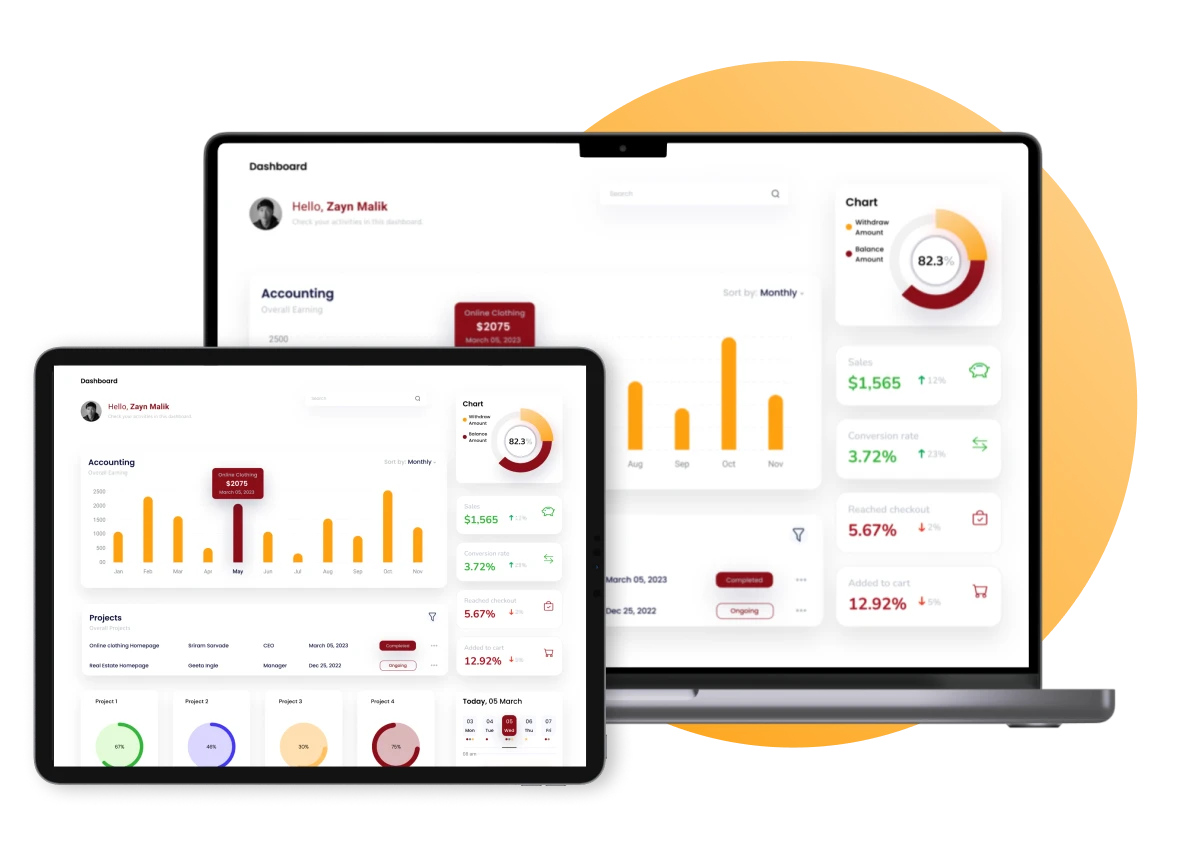Accurately calculating variable and fixed costs is essential for determining production expenses and maximizing profitability. However, doing it manually can be time-consuming and inefficient.
A smarter solution is using an automated accounting system that simplifies cost calculations and provides real-time financial insights. HashMicro’s accounting system streamlines this process, ensuring accuracy and efficiency in managing your business finances.
But what exactly are fixed and variable costs? In this article, we’ll break them down so you can better understand their impact on your business.
Table of Contents

Key Takeaways
|
What is the Variable Cost?
Variable costs are expenses that fluctuate based on the company’s production activities. In other words, these costs can either increase or decrease depending on the level of production carried out by the business. If the company ramps up its production, variable costs will naturally rise. Conversely, if production slows down, these costs will decrease.
Variable costs include raw materials, direct labor, and packaging expenses. For instance, a bakery’s cost for flour, sugar, and other ingredients will increase as it produces more cakes. Similarly, the cost of hourly wages for workers will go up if the company requires more labor to meet higher production demands.
The Functions of Variable Costs
Variable costs play a vital role in the calculation of production expenses, serving several essential functions for companies. Here are some key functions of variable costs:
1. Assisting in short-term decision-making
Variable costs are crucial for companies when making short-term decisions. For example, when a company receives an urgent production order, understanding variable costs allows the business to quickly estimate the production expenses.
This insight helps determine the price of the order and assess whether fulfilling the request will be profitable. Companies can make informed decisions that align with their financial goals by having a clear picture of the costs that fluctuate with production volume.
2. Aiding in cost control
By identifying and separating variable costs from fixed costs in the company’s financial statements, businesses can better understand their expenses. This separation enables companies to focus more effectively on managing the behavior of fixed costs while keeping a close eye on variable costs that fluctuate with production activities.
An integrated accounting system helps businesses more efficiently track and control their expenses, allowing for better cost management and resource allocation.
You can also read our previous article on accounting software philippines recommendations to better understand what accounting systems are of good quality.
3. Simplifying the calculation of short-term profits
Having clear information on variable costs and how they change with production volume is invaluable for calculating short-term profits. By separating these costs and understanding their behavior, companies can easily determine the impact of production levels on profitability.
This detailed cost analysis provides essential insights that help the business make strategic decisions. For instance, if production increases, the company can evaluate how the rise in variable costs affects profits, thereby guiding future short-term planning and decision-making.
Examples of Variable Costs
We have explained the definition and function or use of variable cost itself. However, you must be wondering about what an example of variable cost looks like. Here are some key examples of variable costs that businesses often encounter:
1. Direct materials
Direct materials are the raw materials directly involved in the production process. The quantity of direct materials needed will vary depending on the company’s production. For instance, if a furniture manufacturer increases its production of chairs, it will require more wood, nails, and varnish, all of which are direct materials.
The costs associated with acquiring these materials change in direct proportion to the level of production, making them crucial to variable cost calculation.
2. Commission
Commissions are expenses that depend on the number of products sold or the amount of sales revenue generated. Companies often pay commissions to sales personnel as an incentive for each successful sale. For example, a sales representative might earn a 5% commission on every unit sold.
If sales increase, the total commission expense rises accordingly, making it a variable cost. This is especially important in businesses where sales and production are closely linked, as it directly affects profitability and cost management.
3. Fulfillment of production equipment
The production of goods requires the use of various production equipment, and maintaining this equipment involves variable costs. These expenses include the electricity consumed by machines, oil for maintenance, and other consumables necessary for production operations.
Since equipment use depends on the production volume, the costs associated with running and maintaining these machines will fluctuate accordingly. For example, in a manufacturing plant, the electricity cost will increase as machines operate longer to meet higher production demands. Companies often manage these costs using a Procurement System to ensure efficiency and minimize waste.
4. Labor overtime pay
Labor overtime pay is another key example of variable costs. When production levels rise, employees may be required to work additional hours to meet the increased demand. The cost of paying for this extra labor time varies based on the amount of overtime worked.
For instance, factory workers might need extra shifts during peak seasons, resulting in higher overtime expenses. This additional cost is directly linked to the production volume, highlighting its variable nature within the company’s overall production expenses.
What is Fixed Cost?
Fixed costs refer to expenses a company incurs regardless of production levels. Unlike variable costs, fixed costs remain constant even if production activities increase or decrease. In other words, these costs do not fluctuate with the amount of goods or services the company produces.
Whether the business is running at full capacity or not producing anything at all, fixed costs must still be paid, making them an essential component of a company’s financial obligations.These costs are often associated with the company’s operational infrastructure and are necessary for maintaining its day-to-day operations.
For instance, the company must pay rent for its office or factory space, salaries for permanent employees, insurance premiums, and utility bills like electricity and water, even if no production occurs. This means that fixed costs can be a financial burden, particularly during periods of low production or economic downturns.
However, understanding and managing these costs is crucial for long-term financial planning and stability. By identifying their fixed costs, companies can make more strategic decisions regarding pricing, budgeting, and cost control to ensure profitability.
Functions of Fixed Costs
Fixed costs serve several important functions within a company’s financial structure. One of their primary roles is providing a baseline for determining the production costs. By knowing the fixed costs, a company can quickly calculate its total costs when combined with variable costs.
Additionally, fixed costs are crucial in helping the company assess its capital recovery. By comparing fixed costs against total revenue, a business can determine if it has managed to break even or if it needs to adjust its pricing or production strategies.
This insight is valuable for companies to gauge whether their investments in assets, infrastructure, and other fixed-cost elements yield the desired returns. Moreover, fixed costs simplify the process of calculating profits over a longer period compared to variable costs.
Because fixed costs remain unchanged regardless of production levels, companies can use them to forecast profits and plan for the future more accurately. This long-term perspective allows businesses to set realistic financial goals, make informed decisions about expansions or new investments, and establish more effective pricing strategies to ensure sustainable profitability.
Examples of Fixed Costs
Fixed costs are essential for a company in calculating its overall production expenses. These costs remain constant regardless of the production volume, providing a stable financial foundation. Here are some common examples of fixed costs that companies consider when determining their production costs:
1. Interest expense
Companies often take out loans that incur interest to maintain smooth production and operational processes. In addition to repaying the principal amount of these loans, businesses are also obligated to pay interest regularly, typically monthly,.
This interest payment remains a fixed cost, regardless of how much the company produces. For instance, even if the company experiences a dip in production, the interest expenses must still be paid in full. Therefore, interest expenses can significantly impact a company’s overall financial planning and cash flow management.
2. Insurance
Businesses secure various forms of insurance to protect against potential risks, such as property damage, liability, and operational disruptions. To maintain this coverage, companies must pay monthly insurance premiums, making this a fixed cost. Whether the company is in full production mode or temporarily halts its operations, these insurance payments remain due.
This steady cost ensures that the company is safeguarded against unforeseen events, providing financial security and stability in the long run. The fixed nature of insurance expenses allows companies to plan their budgets more effectively, knowing they have this layer of protection.
3. Utilities
Utilities are another form of fixed costs that companies must pay to keep their operations running smoothly. These include expenses for electricity, water, phone, and other essential services. Even if the company is not producing goods or services, utility bills must be paid regularly to maintain the operational infrastructure.
For example, electricity is required to power equipment, maintain office functions, and provide lighting, regardless of production levels. Companies can better manage their overhead costs and ensure uninterrupted operations by understanding and accounting for these utility expenses.
4. Rental fee
Most companies require physical space to conduct their operations, whether it be offices, warehouses, or manufacturing plants. Renting this space incurs a fixed monthly fee that remains consistent, regardless of how much the company produces.
For instance, whether a factory is operating at full capacity or not producing at all, the rental fee for the premises must still be paid. This fixed cost is a vital part of a company’s budget and must be considered when planning for long-term financial stability. Managing rental expenses effectively can help the company allocate resources for other critical areas, such as production or marketing.
5. Depreciation expenses
Production equipment and machinery experience wear and tear over time, leading to a decrease in their value. This decrease is recorded as depreciation expense, a fixed cost that companies account for annually. Depreciation reflects the gradual loss of value in assets such as manufacturing machines, vehicles, and technology.
Although the company may use the equipment to varying degrees, the depreciation cost remains relatively constant each year. After a certain period, usually a few years, the equipment will need to be replaced or upgraded, prompting the company to invest in new assets. Understanding depreciation expenses allows businesses to plan for future capital expenditures and manage their long-term asset lifecycle effectively.
Fixed Costs vs. Variable Costs: Understanding the Differences
While both fixed and variable costs are key elements in calculating a company’s production expenses, they differ significantly in nature and how they impact overall financial planning. Fixed costs are expenses that do not depend on the company’s production levels.
In other words, these costs remain constant whether the company produces a large quantity of goods or none at all. Examples include rent, salaries of permanent staff, and insurance premiums. These costs provide stability in budgeting but must be paid regardless of production activity.
On the other hand, variable costs fluctuate directly with the company’s production activities. They increase as production volume rises and decrease when production slows down. For instance, the cost of raw materials, direct labor, and commissions are all variable costs that change based on the number of goods produced.
Additionally, fixed and variable costs behave differently when we look at costs on a per-unit basis. Fixed costs impact the unit cost by spreading themselves over the number of units produced. As production increases, the fixed cost per unit decreases because the total fixed cost is allocated across larger units.
Conversely, when production decreases, the fixed cost per unit rises. In contrast, variable costs per unit remain consistent regardless of the production volume. Each unit incurs the same amount of variable cost, allowing companies to predict expenses more accurately as they plan their production activities.
Why Distinguishing Between Fixed Costs and Variable Costs Is Important
In the complicated field of business finance, distinguishing between fixed cost vs variable cost is essential for sound financial management. This understanding gives companies critical insights into their overall cost structure, helping them make informed decisions related to budgeting, pricing strategies, and profitability.
Furthermore, recognizing the difference between fixed and variable costs significantly influences pricing strategies. Businesses must set prices that cover both types of costs and ensure a profit. By understanding the balance between their fixed and variable costs, companies can develop pricing models that align with their financial goals and market competitiveness.
In summary, differentiating between fixed and variable costs is vital for any business. This knowledge enables organizations to optimize resource allocation, implement competitive pricing, and ultimately secure long-term financial success. Therefore, companies must comprehensively understand their cost structure to manage fixed and variable expenses effectively.
Improve the Accuracy of Your Fixed Cost and Variable Cost Calculations with HashMicro Accounting System

Calculating or managing fixed costs and variable costs is not an easy thing, especially if done manually which is more prone to problems, such as misclassification of costs. This error can occur due to considering variable costs such as raw materials as fixed costs, which can result in improper budget planning. Therefore, using an accounting system like HashMicro is important to avoid mistakes.
HashMicro’s accounting system is equipped with a comprehensive range of features that can help with financial management productivity, one of which is fixed costs and variable costs. HashMicro also provides a free demo to give you the opportunity to learn about the system before purchasing.
Furthermore, this system also does not impose a limit on the number of users using this application. This is very influential in ensuring that the management of fixed costs and variable costs becomes more transparent and can avoid fraud or data manipulation.
Here are some features of the HashMicro accounting system that can help manage fixed costs and variable costs:
- Cash Flow Reports: Monitor the company’s cash inflows and outflows to ensure sufficient liquidity, make appropriate financial plans, and identify and address potential financial issues.
- Forecast Budget: Predict future budgets based on historical data to help plan finances, allocate resources efficiently, and make better strategic decisions.
- Financial Statement with Budget Comparison: Provides a clear picture of how the company’s actual financial performance matches the plan to identify deviations and make necessary adjustments to achieve financial goals.
Conclusion
Variable and fixed costs are crucial elements in determining a company’s production expenses and overall profitability. Both play a significant role in calculating total production costs, yet they differ in their nature, as seen in their definitions and unit cost behavior.
HashMicro, a leading ERP software provider in Singapore, offers an efficient solution to streamline the calculation of production costs with its advanced Accounting System, equipped with top-tier features. Additionally, you can manage procurement costs more effectively through their Procurement System. Click here to explore the best deals and request a free demo!




































